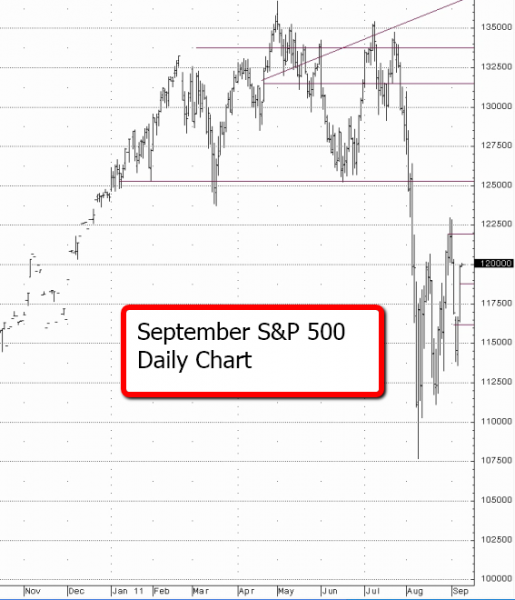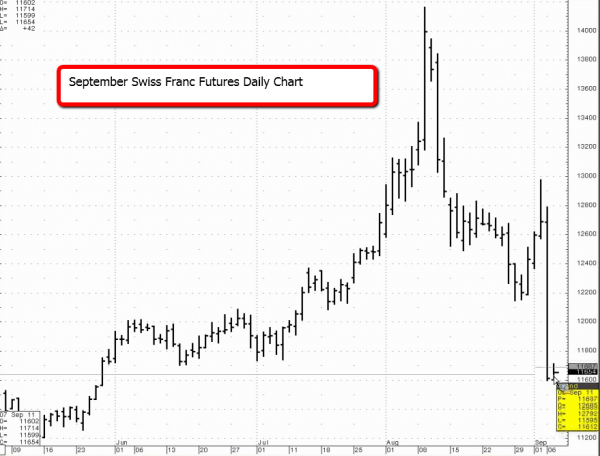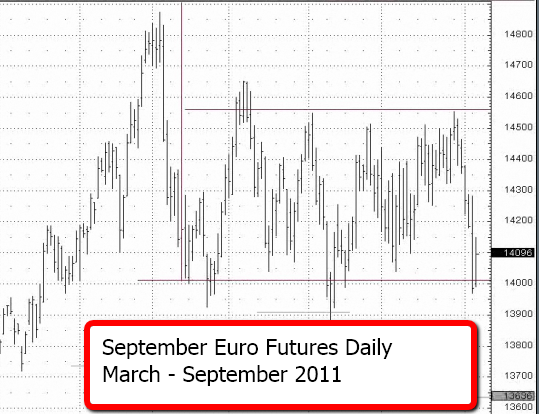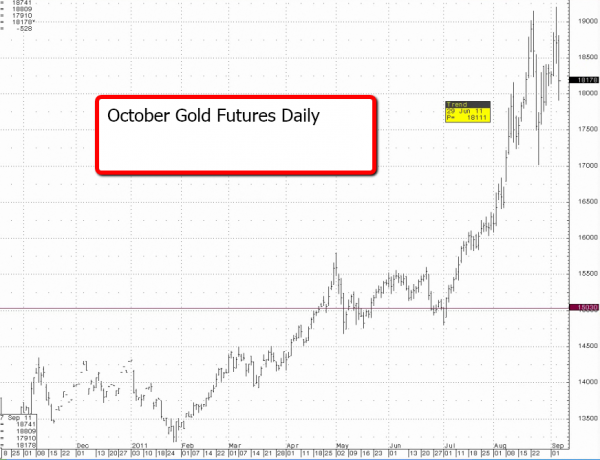by Jeff Friedman
The volatility in the markets over the past couple months has been overwhelming, and it’s due to global uncertainty. It’s not clear exactly where the U.S. economy is headed (recession or no recession), we still have a divided Congress, and Federal Reserve policymakers are likewise divided on what course of action to take to stimulate the economy (QE3 or no QE3?). As a trader, it’s more important than ever to use appropriate risk management techniques in this environment.
In Europe, we have ongoing debt problems, and leaders are working on how to resolve them. Nations such as Greece and Italy have had to enact sweeping austerity measures, which haven’t been popular with the people. We don’t know how or when the problems in the U.S. and Europe will be resolved. The only thing we do know for sure is that volatility has been going up, and this environment is something traders will likely have to get used to.
In the U.S., our number one problem is job creation. We haven’t seen it. Non-farm payrolls were flat in August, and the unemployment rate held steady at 9.1 percent. If the U.S. can’t create more than 150,000 jobs, we will continue to have weak economic growth. At this time, I believe that if we do fall into recession, I think it will be very mild. If people stop consuming goods then that’s a big red flag as consumer spending accounts for roughly 2/3 of our gross domestic product (GDP). If GDP turns negative, I think we could see the S&P 500 slip to 1,000. We can see in the chart of the S&P 500 how the jobs report and European problems impacted the S&P 500, which turned sharply lower this summer.
In the next 30-45 days I think it will become very clear whether we are heading into a double dip recession or not. We’ll see what manufacturing data, consumer sentiment, consumption and employment show. In the meantime, I think the markets will remain volatile. I will point out a few markets were this has been evident, and offer some strategies to cope.

Swiss Franc
You can see this volatility evident in the chart of two markets regarded as “safe havens” among investors–the Swiss franc and gold. The Swiss franc had been moving steadily higher, and this week the Swiss National Bank said enough is enough. It intervened, linking the franc to the euro. That pushed the franc down sharply—about an 8 percent move. You could’ve lost a lot that day if you were on the wrong side of the market! We can see the big spike lower in the chart of the Swiss franc.

Euro
Looking at the euro, this market has likewise been volatile, but has been trading in a huge channel between $1.40 – $1.45. Traders who played this range were successful buying on dips to the bottom of that range and selling at the top of the range. Until we get a close two days in a row, or on a weekly basis, above $1.46 or below $1.40, I think that trading strategy within the channel should hold.

Gold
Gold has been in a huge bull market, no question, but the volatility in gold has become overwhelming. The normal daily range for this market was about $10, now we are seeing swings of $40, $50 even $60 or more. One way to cope with this volatility is to consider trading mini-sized gold contracts, or for smaller investors, an E-micro contract. The E-micro contract is offered at CME Group, and is one-tenth the size of its full-sized benchmark contract. In the full-sized gold contract, a $100 move in gold is worth $10,000, while in the micro contract, a $100 move is worth $1,000. Your margin requirement is also one-tenth the size. This volatility is something traders have to get used to.
We can also see the big spike higher in gold as investors drove the market to a new record high of $1,923.70 an ounce on Tuesday, September 6, 2011. On Wednesday, September 7, the market took a big tumble as some of the air was let out of the market and gold closed down $55.70 an ounce. I still believe there are reasons to remain bullish gold, as continued uncertainty should continue to drive the market up. So far, pullbacks have been met by renewed buying interest, and that seems to be the case this week. Gold was back up about $40 in early trading on Thursday, September 8.

Risk Management
In this type of volatile environment, risk management is critical. Every trader wants to hit a big home run, but it is foolish to risk your entire account, or even half your account, on one trade. Many markets are moving 2 – 4 percent in a day, and some I’ve shown you are even larger. You can be quickly wiped out given these conditions. Futures trading should only be pursued with risk capital, and one rule of good money management is to never have more than 5 – 10 percent of your total risk capital on the line in any one trade. So if your account size (risk capital) is $20,000, you wouldn’t want to risk more than $2,000 on one trade. I’m not taking about the margin (performance bond) you need to put up to enter your trade or maintain your position, I’m talking about what you are willing to risk losing on a particular trade if it goes against you and you have to bail out.
Your trading time frame and frequency can help determine the appropriate amount to risk within that 5 – 10 percent range. If you are a day trader, I would recommend you risk less (closer to 5 percent), because you are going to be trading more and want to leave yourself more ammunition. If you are a swing trader and you trade less often, you can risk a little more. If you are a position trader with a longer-term trading focus and less trading frequency, you can risk the most, perhaps you can risk a full10 percent.
Let’s look at how that would work in practice. I am going to simply define my risk and reward based on contract values for the purposes of this discussion. Let’s assume I have a $25,000 account and I want to risk 5 percent, or $1,250, on one trade. If you are looking at trading CME E-mini S&P 500 futures, you will see in the contract specifications that each one-point move is worth $50. That means if I wanted to risk $1,250, the market can move 25 points against me before I’m out. If I buy a contract, I’d want to place my stop-loss 25-points lower. If I sell a contract, I’d place my stop-loss 25-points higher. I always recommending using stops, and key technical levels can help you determine where to put your stops.
Often in volatile markets, you can get stopped out of your position, and the market will quickly reverse, leaving you out of the trade. Options offer a way to get involved in the markets and weather these short-term fluctuations while maintaining a market position. Options also offer you the ability to clearly define your risk, so you can determine your maximum possible loss if your worse-case scenario occurs and the market moves against you. Various spread strategies can be particularly useful in volatile markets when you aren’t exactly sure which way the market is going to break.
Vertical spreads involve buying and selling multiple options of the same underlying market, with the same expiration date but with different strike prices. In a bull call spread, the price you pay for a call with a lower strike price is partially offset by collecting premium from selling a call with a higher strike price. In a bear put spread, the price you pay for a put with a higher strike price will be partially offset by the premium you collect from selling a call with a lower strike price. These strategies are considered “hedged” strategies which offer you the opportunity to profit on a bullish or bearish longer-term market view, but limit your losses if you are wrong and the market moves against your view.
This is not an options webinar, so I won’t get into too much detail on various options strategies here—I encourage you to call me to explore these concepts further. If you would like more detail on various risk-management techniques, including how to use technical analysis to determine appropriate entry and exit points, please read my previous article, “Money Management: The Difference Between Success and Failure.”
These are my general thoughts and trading ideas at this point in time, and not to be taken as specific trading recommendations. These ideas may change at any time as conditions change in the markets. For more specific strategies tailored to your unique risk tolerance and goals, I encourage you to contact me.
Jeff Friedman is a Senior Market Strategist with MF Global. He can be reached at 866-231-7811 or via email at jfriedman@mfglobal.com
Futures trading involves substantial risk of loss and is not suitable for all investors.
Past performance is not necessarily indicative of future trading results. Trading advice is based on information taken from trade and statistical services and other sources which MF Global believes are reliable. We do not guarantee that such information is accurate or complete and it should not be relied upon as such. Trading advice reflects our good faith judgment at a specific time and is subject to change without notice. There is no guarantee that the advice we give will result in profitable trades. All trading decisions will be made by the account holder.
@2011 MF Global Ltd. All Rights Reserved. Futures Brokers, Commodity Brokers and Online Futures Trading. 141 West Jackson Boulevard, Suite 1400-A, Chicago, IL 60604.



